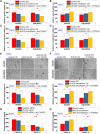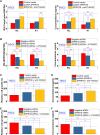Identification of oral squamous cell carcinoma markers MUC2 and SPRR1B downstream of TANGO
- PMID: 33620575
- PMCID: PMC11802022
- DOI: 10.1007/s00432-021-03568-9
Identification of oral squamous cell carcinoma markers MUC2 and SPRR1B downstream of TANGO
Abstract
Purpose: Transport and Golgi organization protein 1 (TANGO) promotes angiogenesis and lymphangiogenesis in oral squamous cell carcinoma (OSCC). To elucidate the underlying mechanisms, this study aims to identify and characterize elements downstream of TANGO that mediate its involvement in OSCC.
Methods: In this study, microarray analysis compared gene expression between control and TANGO-repressed HSC3 cells. Protein expression in 213 OSCC tissue samples was analyzed immunohistochemically.
Results: TANGO repression decreased or increased expression of Mucin 20 (MUC20) and small proline-rich protein 1B (SPRR1B), respectively. MUC20 increased the growth and invasiveness of OSCC cells via altered matrix metalloproteinase (MMP)-2 and E-cadherin expression and c-met phosphorylation. MUC20 induced angiogenesis and lymphangiogenesis by activating vascular endothelial growth factors A and C. In well-differentiated OSCC, SPRR1B expression was high (P = 0.0091) and correlated with keratinization markers and promoted proliferation by inducing mitogen-activated protein kinase p38 phosphorylation. MUC20 expression correlated significantly with clinical stage (P = 0.0024), lymph node metastasis (P = 0.0036), and number of blood and lymph vessels (P < 0.0001). MUC20-expressing cases had a significantly worse prognosis than non-expressing cases (P < 0.0001).
Conclusion: MUC20 and SPRR1B located downstream of TANGO may be useful molecular markers for OSCC.
Keywords: MUC20; Oral cancer; SPRR1B; TANGO.
Conflict of interest statement
All authors declare that they have no conflict of interest.
Figures






Similar articles
-
Bioinformatics identification and validation of m6A/m1A/m5C/m7G/ac4 C-modified genes in oral squamous cell carcinoma.BMC Cancer. 2025 Jul 1;25(1):1055. doi: 10.1186/s12885-025-14216-7. BMC Cancer. 2025. PMID: 40597017 Free PMC article.
-
Total m6A RNA levels and VIRMA expression as potential diagnostic and prognostic markers in oral squamous cell carcinoma.Diagn Pathol. 2025 Jul 3;20(1):81. doi: 10.1186/s13000-025-01678-3. Diagn Pathol. 2025. PMID: 40611263 Free PMC article.
-
The Patterns of P53, E-Cadherin, β-Catenin, CXCR4 and Podoplanin Expression in Oral Squamous Cell Carcinoma Suggests a Hybrid Invasion Model: an Immunohistochemical Study on Tissue Microarrays.Head Neck Pathol. 2025 Jan 7;19(1):6. doi: 10.1007/s12105-024-01745-z. Head Neck Pathol. 2025. PMID: 39776043
-
Prognostic value of CD44 expression in oral squamous cell carcinoma: A meta-analysis.Ann Diagn Pathol. 2023 Dec;67:152213. doi: 10.1016/j.anndiagpath.2023.152213. Epub 2023 Oct 18. Ann Diagn Pathol. 2023. PMID: 37856951
-
The Role of Glucose Transporters in Oral Squamous Cell Carcinoma.Biomolecules. 2021 Jul 21;11(8):1070. doi: 10.3390/biom11081070. Biomolecules. 2021. PMID: 34439735 Free PMC article.
Cited by
-
Construction and comprehensive analysis of a novel prognostic signature associated with pyroptosis molecular subtypes in patients with pancreatic adenocarcinoma.Front Immunol. 2023 Feb 3;14:1111494. doi: 10.3389/fimmu.2023.1111494. eCollection 2023. Front Immunol. 2023. PMID: 36817451 Free PMC article.
-
Prognostic significance of elevated expression levels of protein phosphatase 1 regulatory subunit 3G in thyroid carcinoma.Oncol Lett. 2024 Nov 28;29(2):82. doi: 10.3892/ol.2024.14828. eCollection 2025 Feb. Oncol Lett. 2024. PMID: 39664612 Free PMC article.
-
High-Multiplex Aptamer-Based Serum Proteomics to Identify Candidate Serum Biomarkers of Oral Squamous Cell Carcinoma.Cancers (Basel). 2023 Mar 30;15(7):2071. doi: 10.3390/cancers15072071. Cancers (Basel). 2023. PMID: 37046731 Free PMC article.
-
The Multifaceted Roles of Proline in Cell Behavior.Front Cell Dev Biol. 2021 Aug 12;9:728576. doi: 10.3389/fcell.2021.728576. eCollection 2021. Front Cell Dev Biol. 2021. PMID: 34458276 Free PMC article. Review.
-
Prognostic role of MUCIN family and its relationship with immune characteristics and tumor biology in diffuse-type gastric cancer.Heliyon. 2024 May 16;10(10):e31403. doi: 10.1016/j.heliyon.2024.e31403. eCollection 2024 May 30. Heliyon. 2024. PMID: 38803848 Free PMC article.
References
-
- Arndt S, Bosserhoff AK (2006) TANGO is a tumor suppressor of malignant melanoma. Int J Cancer 119:2812–2820. 10.1002/ijc.22242 - PubMed
-
- Arndt S, Bosserhoff AK (2007) Reduced expression of TANGO in colon and hepatocellular carcinomas. Oncol Rep 18:885–891 - PubMed
-
- Bray F, Ferlay J, Soerjomataram I, Siegel RL, Torre LA, Jemal A (2018) Global cancer statistics 2018: GLOBOCAN estimates of incidence and mortality worldwide for 36 cancers in 185 countries. CA Cancer J Clin 68:394–424. 10.3322/caac.21492 - PubMed
-
- Chen CH et al (2013) MUC20 overexpression predicts poor prognosis and enhances EGF-induced malignant phenotypes via activation of the EGFR-STAT3 pathway in endometrial cancer. Gynecol Oncol 128:560–567. 10.1016/j.ygyno.2012.12.012 - PubMed
-
- Chen CH et al (2016) MUC20 promotes aggressive phenotypes of epithelial ovarian cancer cells via activation of the integrin β1 pathway. Gynecol Oncol 140:131–137. 10.1016/j.ygyno.2015.11.025 - PubMed
MeSH terms
Substances
Grants and funding
LinkOut - more resources
Full Text Sources
Other Literature Sources
Molecular Biology Databases
Research Materials
Miscellaneous

